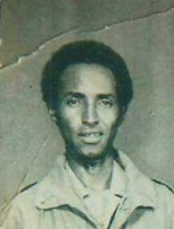Mohamed Hashi Lihle
Mohamed Hashi Dirie (
Biography

Early life and career
Lihle attended the SOS Sheikh Secondary School for boys. Once he graduated he joined the Somali military. As he was among the most skilled officers, he was sent to the Soviet Union for further advanced-level training. Upon his return Lihle was stationed at the Kismayo Military academy where he trained the next generation of army cadets. Lihle participated in the Ogaden War and was considered a War hero within the Somali Armed Forces.[3] During the course of his army career he held the ranks of first and second lieutenant (Xidigle), Captain (Dhamme), Major (Gaashaanle), Lieutenant Colonel (Gaashaanle Dhexe) and Colonel (Gaashaanle sare). The latter rank is the third-highest a commissioned officer can achieve in the Somali National forces.[citation needed]
Somali National Movement
Lihle joined the Somali National Movement, an organization consisting mainly of members of the
Lihle's speech to the freed Mandera prisoners:
O prisoners, you are from everywhere.'- Now we will release you. You have three options to choose from: (1) whoever wants to join the SNM, as we are fighting the regime, you can come and join the Jihad (struggle); (2) whoever wants to go and join his family, we will help you get back home; (3) whoever wants to join the regime, you should know we pushed them back to Abdaal when we came; so go to them and we will not do anything to you until you reach them. But be careful: we might attack you later and then our bullets will hurt you. So choose one of these options.
New African Magazine in 1989 states:
The SNM is very popular among the Somalis especially in the Northern Regions. Within the six year period that they were operating from Ethiopia, they carried out many successful military operations and created military heros like Mohamed Ali, Colonel Lihle, and Captain Ibrahim Kodbur.[8]
Death
In October 1984 the SNM commando units led by Colonel Lihle clashed with the SNA at the Somali-Ethiopia border town of Burao-Durey. The SNM suffered heavy losses and Lihle died on the battlefield. His death was considered a major blow to the SNM movement. Lihle is considered a hero in Somaliland and has roads and districts named after him.[9]
See also
- Mohamed Farah Dalmar Yusuf
- Hassan Adan Wadadid
- Abdiqadir Kosar Abdi
- Abdirahman Ahmed Ali
References
- ^ Xasuus Qor, Faarax M. Maxamed, 2004. pp134-144
- ^ Dharaaraa Ina Soo Maray, Boobe Yuusuf. pp.350
- ^ Prunier, Gerard (2021). The Country That Does Not Exist: A History of Somaliland.
- ^ "US Department of the Army: Analysis of Somalia, December 1993". www.africa.upenn.edu. Retrieved 28 October 2020.
- )
- ^ Blood and Bone The Call of Kinship in Somali Society, I.M Lewis, pp.183.
- ISSN 1354-5078.
- ^ New African, Issues 257-259; Issues 262-266. pp.31
- ^ Sub-Saharan Africa Report, Issue 1; Issue 7.PP.53
